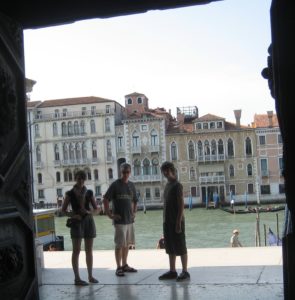
The McKee family poses at the Santa Maria della Salute in front of the Grand Canal on a trip to Venice. (Photo by Melody McKee)
It’s been too long since I got to go to Europe, so I settled for watching A&E’s “The Miraculous Canals of Venice,” a forty minute documentary available on YouTube and also as “instant viewing” on Netflix. It’s a way to get a dose of Venezia without having to even get out of your chair. I love getting a brief overview of a place with interesting history, especially if the emphasis is on interesting big-picture stuff and not so much on political details and dates.
Some have said Venice is the most beautiful city in the world, but I think there might be better word choices. (Besides, everybody knows Paris wins the beauty title.) Maybe they meant the most “beguiling.” There are waterways large and small, with boats on the move and boats at rest. Majestic palazzo style houses crowd together with grand doors at water level. Arched bridges abound along the narrow and shady maze-like walkways. Along the water’s edge are moss covered marble steps. Flowering vines hang exquisitely on thousand year old brick walls.
There’s nothing quite like it in the world. Beyond the striking visuals, there is an amazing backstory about how such a world-class city so rich and dense with splendor could possibly prosper in the middle of a swampy lagoon. Therein lies our tale.
It started when Barbarian hordes began raiding northern Italy in the fifth century forcing the locals to flee to the only safe land available, the swampy islands in the middle of a watery lagoon that lay just off the coast. The raiders were unwilling to chase their victims into such an inhospitable bog, so the settlers set up temporary huts and then returned to the mainland after the murderous hordes moved on. These invaders were the same ones who famously managed to finish off the last of the Roman Empire further down the peninsula.
When raids continued again and again, more and more people set up to live permanently on some of the islands. They brought in wood to create lightweight structures that wouldn’t sink in the mud. A culture of fishing and getting around in boats became the way of life.
Almost every resource had to be imported to create a life in the marsh except for one product that they were ideally suited to produce: Salt. And in the days of no refrigeration, salt was extremely coveted as a food preservative, and the Venetians were in an ideal situation to create it and then ship it by boat to Europe. Prosperity ensued.
A settlement that had been born from fear was transforming itself into a self assured major player in the world. As the Venetians became wealthier they wanted nicer buildings for themselves. Someone finally figured out they could create stable building sites by driving pointed logs straight down into the mud until these log piles were stopped by stiffer soil. By crowding many of these piles right next to each other they could create a stable support for thick slabs of saltwater-resistant marble that would serve as a platform for large heavy brick structures. As long as the many wood posts stayed wet they never rotted and even slowly petrified with water minerals into stone. Very fortuitous how that worked out. Millions and millions of these log piles were used to create the city.
When Venice started doing well it became a place worthy of being looted, but the invaders never could steer their boats very well through the surrounding mudflats. There was a definite “home field advantage” for Team Venezia. For added security, the center of city government was moved to the larger isolated “Rialto” Island that is now considered the heart of Venice.
Because the city’s natural water defenses worked better than any moat, the city had no need for a defensive perimeter wall. While the rest of Europe had to build heavy stone castle fortresses for safety from pillagers, the Venetian merchants could focus on luxury in their elaborate palaces open to the light and air of the Grand Canal in Venice. A building type emerged of a four or five story palazzo built tight to its neighbors with a ground floor that was used as a warehouse for merchandise to come and go by boat, while the owners lived in grand rooms on the upper floors.
There you have it, armchair explorers, how such an unlikely city came to be in such an unlikely place – as I understood it from an interesting TV documentary, backed up by some online fact-checking. Of course I’ve neglected to elaborate on the centuries of their history as leaders of world trade; the torture of perceived enemies; the theft by Venetians of the remains of the Apostle Mark from Egypt so that Venice could have a big time patron saint; more torture of enemies; the implementation of checks and balances in governing themselves; yet more torture; and so on. I will save that for the real historians.
Hardcore fans of Venice should make a point to visit Google Maps and use “earth view” to see the whole city in virtual 3D. It’s very cool zooming around and down through the canals and city squares.
Steve McKee is a Benicia architect.
He can be reached on the web at: www.smckee.com or at (707) 746-6788
A version of this column originally ran in 2012.
All rights reserved.






Leave a Reply